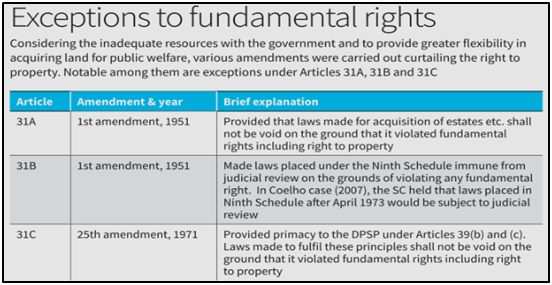Why in News?
There have been heated exchanges between the ruling government and the Opposition with respect to the redistribution of wealth during the ongoing election campaign.
The Supreme Court has also constituted a nine-judge Bench to interpret the Directive Principles of State Policy (DPSP) with respect to ownership and control of material resources.
What’s in Today’s Article?
- What does the Constitution Provide with Respect to the Redistribution of Wealth?
- What is the Historical Context of the Redistribution of Wealth?
- What is the Current Debate on the Redistribution of Wealth?
- What can be the Way Forward?
What does the Constitution Provide with Respect to the Redistribution of Wealth?
- The Preamble to the Constitution aims to secure to all citizens social and economic justice, liberty and equality.
- Part III of the Constitution lists down the fundamental rights that guarantee liberty and equality.
- Part IV of the Constitution contains the DPSP. DPSPs are principles that the central and State governments should follow to achieve social and economic justice in the country.
- Unlike the fundamental rights in Part III, the DPSP is not enforceable in court. They are nevertheless fundamental in the governance of the country.
- Article 39(b) and (c) in Part IV contain principles that are aimed at securing economic justice. They provide -
- That ownership and control of material resources of the society should be distributed to serve the common good and
- That the operation of the economic system does not result in concentration of wealth to the common detriment.
What is the Historical Context of the Redistribution of Wealth?
- The Constitution originally guaranteed the right to property as a fundamental right under Article 19(1)(f).
- It provided under Article 31 that the state shall pay compensation in case of acquisition of private property.
- Considering the inadequate resources with the government and in order to provide greater flexibility in acquiring land for public welfare, various amendments were carried out curtailing the right to property.

- The SC in various cases has interpreted the relationship between fundamental rights and the DPSP.
- Most of these cases were against constitutional amendments made by the state that curtailed the right to property that was then a fundamental right.
- In the Golak Nath case (1967), the SC held that fundamental rights cannot be abridged or diluted to implement DPSP.
- In the Kesavananda Bharati case (1973), a 13-judge Bench of the SC upheld the validity of Article 31C but made it subject to judicial review.
- In the Minerva Mills case (1980), the SC ruled that the Constitution exists on a harmonious balance between fundamental rights and DPSP.
- In 1978, in order to avoid excessive litigation directly in the SC by the propertied class, the 44th amendment act omitted right to property as a fundamental right and made it a constitutional right under Article 300A.
- Any law to acquire private property by the state should be only for a public purpose and provide for adequate compensation.
What is the Current Debate on the Redistribution of Wealth?
- Indian governments in the first four decades after independence followed a “socialistic model” of economy.
- The economic policies resulted in the nationalisation of banking and insurance, extremely high rates of direct taxes (even up to 97%), estate duty on inheritance, tax on wealth etc.
- The rationale behind these measures during those times was to reduce inequality and redistribute wealth among the poorer sections who constituted the majority of the population.
- However, such measures stifled growth and also resulted in the concealment of income/wealth.
- Taxes like estate duty and wealth tax generated revenue that was much less than the cost incurred in administering them.
- The nineties saw the country move from a closed economy towards liberalisation, globalisation and privatisation.
- A new industrial policy was unveiled in 1991 with the objective of empowering market forces, improving efficiency and rectifying deficiencies in the country’s industrial structure.
- Estate duty was abolished in 1985 and wealth tax in 2016.
- The market driven economy has resulted in additional resources for the government that has helped in bringing people out of abject poverty.
- Nonetheless, this economic system has also resulted in growing inequality.
- A report by the World Inequality Lab states that the top 10% of the country’s population have a share of 65% and 57% of the wealth and income respectively as of 2022-23.
- The bottom 50% on the other hand have a meagre share of 6.5% and 15% of the wealth and income respectively.
- The manifesto for the current Lok Sabha elections of the Congress promises that there would be a financial survey to ascertain the distribution of wealth among the people in the country and address the issue of inequality.
- The ruling party campaigners led by the PM have targeted the Opposition on this matter.
- The SC meanwhile has constituted a nine-judge Bench to interpret whether material resources under Article 39(b) include private resources as well.
What can be the Way Forward?
- Growing inequality is a worldwide problem of a liberalised open-market economic system.
- It is the responsibility of the government to protect the interest of the poorer classes who are most dependent on the state machinery for their livelihood.
- At the same time past policies of extremely high tax rates, estate duty, wealth tax etc., did not achieve their desired goals. Instead, they only led to concealment of income and wealth.
- Innovation and growth should not be curtailed but the benefits of growth should reach all sections especially the marginalised.
- Therefore, the policies need to be framed after adequate debate in line with current economic models, with economic justice for all as enshrined in the Indian Constitution as the underlying principle of these policies.










